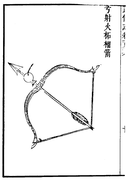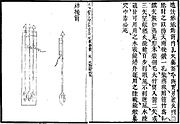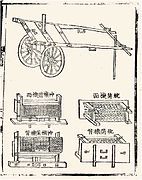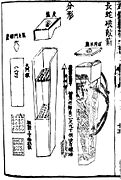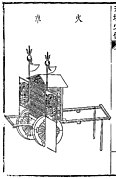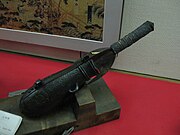Fire arrow

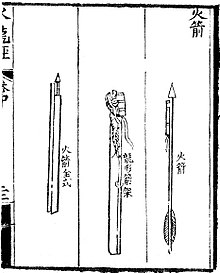
Fire arrowswere one of the earliest forms of weaponizedgunpowder,being used from the 9th century onward. Not to be confused with earlier incendiary arrow projectiles, the fire arrow was a gunpowder weapon which receives its name from the translated Chinese termhuǒjiàn( hỏa tiễn ), which literally means fire arrow. In China a 'fire arrow' referred to a gunpowder projectile consisting of a bag of incendiary gunpowder attached to the shaft of an arrow. Fire arrows are the predecessors offire lances,the first firearm.[1]
Laterrocketsutilizing gunpowder were used to provide arrows with propulsive force and the termfire arrowbecame synonymous with rockets in theChinese language.In other languages such asSanskrit'fire arrow' (agni astra) underwent a different semantic shift and became synonymous with 'cannon'.[2]
Design[edit]
Although the fire arrow is most commonly associated with itsrocketmechanism,[3]it originally consisted of a pouch ofgunpowderattached to an arrow. This type of fire arrow served the function of an incendiary and was launched using a bow or crossbow.
According to theWujing Zongyaothe fire arrow was constructed and used in the following manner:
Behind the arrow head wrap up some gunpowder with two or three layers of soft paper, and bind it to the arrow shaft in a lump shaped like a pomegranate. Cover it with a piece of hemp cloth tightly tied, and sealed fast with molten pine resin. Light the fuse and then shoot it off from a bow.[4]
Incendiary gunpowder weapons had an advantage over previous incendiaries by using their own built-in oxygen supply to create flames, and were therefore harder to put out, similar toGreek fire.However unlike Greek fire, gunpowder's physical properties are solid rather than liquid, which makes it easier to store and load.[4]
The rocket propelled fire arrow appeared later. By the mid-14 century rocket arrow launchers had appeared in theMing dynastyand later on mobile rocket arrow launchers were utilized in China and later spread to Korea. The fire arrows propelled by gunpowder may have had a range of up to 1,000 ft (300 m).[5]
History[edit]


The fire arrows were first reported to have been used by theSouthern Wuin 904 during the siege ofYuzhang.[1]
In 969, gunpowder propelled rocket arrows were invented by Yue Yifang and Feng Jisheng.[7]
In 975, the state ofWuyuesent to the Song dynasty a unit of soldiers skilled in the handling of fire arrows. In the same year, the Song used fire arrows to destroy the fleet ofSouthern Tang.[8]
Published in 1044, theWujing Zongyao,orComplete Compendium of Military Classics,states that in 994 the city of Zitong was attacked by aLiaoarmy of 100,000 men who were driven back by regular war machines and fire arrows.[8][9]
In 1083, Song records state that the court produced 350,000 fire arrows and sent them to two garrisons.[10]
On March 1, 1126, theSonggeneral Li Gang used a fire arrow machine known as theThunderbolt throwerduring theJingkang Incident.[11]
By 1127, the Jin were also using fire arrows produced by captured Song artisans.[12]
In 1159, fire arrows were used by the Song navy in sinking a Jin fleet.[13]
In 1161, the generalYu Yunwenused fire arrows at theBattle of Caishi,near present-dayMa'anshan,during a Jin maritime incursion.[14]
By 1206, "gunpowder arrows" (huoyaojian) rather than just "fire arrows" (huojian) were mentioned.[15]
In 1245, a military exercise was conducted on theQiantang Riverusing what were probably rockets.[16][15]
TheMongolsalso made use of the fire arrow during their campaigns in Japan.[17]Probably as a result of the Mongolian military campaigns the fire arrows later spread into theMiddle East,where they were mentioned by Al Hasan Al Ramma in the late 13th century.[18]
In 1374, the kingdom ofJoseonalso started producing gunpowder and by 1377 was producing cannons and fire arrows, which they used againstwokoupirates.[19][20][21]Korean fire arrows were used against the Japanese during the invasion of Korea in 1592.[22]
In 1380, an order of "wasp nest" rocket arrow launchers were ordered by the Ming army and in 1400 rocket arrow launchers were recorded to have been used byLi Jinglong.[23]
In 1451, a type of mobile rocket arrow launcher known as the "MunjongHwacha"was invented in Joseon.[24]
The Japanese version of the fire arrow was known as thebo hiya.The Japanese pirates (wokou,also known as wako or kaizoku) in the 16th century were reported to have used the bo hiya which had the appearance of a large arrow. A burning element made from incendiary waterproof rope was wrapped around the shaft and when lit the bo hiya was launched from a mortar like weaponhiya taihouor a wide boreTanegashima matchlock arquebus.During one sea battle it was said the bo hiya were "falling like rain".[25]
Rocket invention[edit]
The dating of the appearance of the gunpowder propelled fire arrow, otherwise known as arocket,more specifically asolid-propellant rocket,is disputed. TheHistory of Songattributes the invention to two different people at different times, Feng Jisheng in 969 andTang Fuin 1000. HoweverJoseph Needhamargues that rockets could not have existed prior to the 12th century since the gunpowder formulas listed in theWujing Zongyaoare not suitable as rocket propellant.[26]According to Stephen G. Haw, there is only slight evidence that rockets existed prior to 1200 and it is more likely they were not produced or used for warfare until the latter half of the 13th century.[27]
Gallery[edit]
-
A fire arrow from theWubei Zhi
-
Depiction of fire arrows known as "divine engine arrows" (shen ji jian thần cơ tiễn ) from theWubei Zhi.
-
Depiction of a stationary fire arrow (rocket arrow) launcher from theHuolongjing.
-
Illustration of ahwachamanual from theGukjo-oryeui( quốc triều ngũ lễ nghi, Five Rites of State)
-
An illustration of fire arrow launchers as depicted in theWubei Zhi.The launcher is constructed using basketry.
-
A "charging leopard pack" rocket arrow launcher as depicted in theWubei Zhi.
-
A "nest of bees" (yi wo feng nhất oa phong ) rocket arrow launcher as depicted in theWubei Zhi.So called because of its hexagonal honeycomb shape.
-
A "long serpent" fire arrow launcher as depicted in theWubei Zhi.It carries 32 medium small poisoned rocket arrows and comes with a sling to carry on the back.
-
The 'convocation of eagles chasing hare arrow' from theWubei Zhi.A double ended rocket arrow pod that carries 30 small poisoned rocket arrows on each end for a total of 60 rocket arrows. It carries a sling for transport.
-
Ahwachafrom theYungwon pilbi
-
A life size reconstruction of ahwachathat launchessingijeons- the Korean fire arrow.
-
Korean fire arrows
-
Antique Japanese (samurai)bo hiyaorbohiya(fire arrow) andhiya taihou(fire arrow cannon), Kumamoto Castle, Japan.
-
Antique Japanese (samurai)bohiyaorbo hiya(fire arrow), showing the fuse, Kumamoto Castle, Japan.
See also[edit]
References[edit]
- ^abAndrade 2016,p. 31.
- ^Needham 1986,p. 68.
- ^The History of Early Fireworks and Fire ArrowsArchived2020-04-10 at theWayback Machine— About.com
- ^abNeedham 1986,p. 154.
- ^"History of Rocketry: Ancient times to the 17th Century".Spaceline.org.Retrieved2013-05-31.
- ^Needham 1986,p. 43, 259, 578.
- ^Liang 2006.
- ^abNeedham 1986,p. 148.
- ^This New Ocean: The Story of the First Space Age(Google eBook), William E. Burrows, Random House Digital, Inc., Nov 5, 1999P.8
- ^Andrade 2016,p. 32.
- ^( tĩnh khang nguyên niên nhị nguyệt lục nhật ) thị tịch, túc vu hàm phong môn, dĩ kim nhân tiến binh môn ngoại, trị công cụ cố. Tiên thị, thái mậu hào lệnh tương sĩ, kim nhân cận thành bất đắc triếp thi phóng, hữu dẫn pháo cập phát sàng tử nỗ giả, giai trượng chi, tương sĩ phẫn nộ. Dư ( lý cương ) kí đăng thành, lệnh thi phóng, hữu dẫn pháo tự tiện, năng trung ( kim ) tặc giả, hậu thưởng. Dạ, phát “Phích lịch pháo” dĩ kích, ( kim ) tặc quân giai kinh hô. (Rough Translation: [On March 1, 1126 (Gregorian calendar)] In the evening, I slept at the gate of Xianfeng, as the Jin army arrived at the gate and nourishing their weapons. Earlier, Cai Mao had ordered the men that they were not allowed to fire on the Jin soldiers whoever came near, any firing from trebuchets and ballistas were to be caned, and the soldiers were irritate by the order. Once arrived at the walls, I had ordered them to fire, for those who could hit the enemy were to be extensively rewarded. At night, they launched the "thunderbolt pao" at the enemy, and they were all shocked.) Records of Messages from the Jingkang Era ch. 2 (author: Li Gang)
- ^Andrade 2016,p. 34-35.
- ^Andrade 2016,p. 39.
- ^( thiệu hưng tân dĩ niên ) ngã chu phục vu thất bảo sơn hậu, lệnh viết: “Kỳ cử tắc xuất giang!”. Tiên sử nhất kỵ yển kỳ vu sơn chi đỉnh, tý kỳ bán tế, hốt sơn thượng trác lập nhất kỳ, chu sư tự sơn hạ hà trung lưỡng bàng đột xuất đại giang, nhân tại chu trung, đạp xa dĩ hành thuyền. Đãn kiến thuyền hành như phi, nhi bất kiến hữu nhân, ( kim ) lỗ dĩ vi chỉ thuyền dã. Chu trung hốt phát nhất “Phích lịch pháo”, cái dĩ chỉ vi chi, nhi thật chi dĩ thạch hôi, lưu hoàng. Pháo tự không nhi hạ lạc thủy trung, lưu hoàng đắc thủy nhi hỏa tác, tự thủy khiêu xuất, kỳ thanh như lôi, chỉ liệt nhi thạch hôi tán vi yên vụ, mị kỳ nhân mã chi mục, nhân vật bất tương kiến. (Rough Translation: [Year 1161] Once our ships had hid behind the Mount Qibao, an order was given to launch out followed after the signal. Earlier, a mounted scout was sent atop the peak to watch over half cross the river, suddenly a signal was shown from the peak, and the ships came out from the river on both sides at the foot, all men on board tread as to move the ship. The ships seemed to move swiftly without sails or oars, so the savages [Jin] conceived that those were paper boats. Then, the paddle wheelers launched the "thunderbolt pao" at their enemy on a sudden, which were made of paper pots, packed with lime and sulfur. When alight, they exploded upon impact with the water, and bounce out, making a noise like thunder. The pots were cracked and lime scattered into a smoky fog, blinding and terrifying the enemy men and horses.) Collection from the Sincerity Studio ch. 44 (author:Yang Wanli)
- ^abNeedham 1986,p. 511.
- ^Needham 1986,p. 132.
- ^ese%20fire%20arrow&f=trueThe rocket,New Cavendish books, 1978ISBN0-904568-10-5P.10
- ^+fire+arrow&hl=en&sa=X&ei=ljQ3T5PAI5C2twfcsqy7Ag&ved=0CDcQ6AEwAQ#v=onepage&q=Sin gijeon%20fire%20arrow&f=trueThe rocket,New Cavendish books, 1978ISBN0-904568-10-5P.2
- ^Chase 2003,p. 173.
- ^:8erR2mluxYcJ:www.koreanhero.net/fiftywonders/FiftyWonders2_English.pdf+&hl=en&gl=us&pid=bl&srcid=ADGEESjsozg5IL81-jP_Lw-c-YL2MBdYFKnU8_7GBsZr_A84mNbnR5pOLhN2e- Xc7Fdk7NAgj5IngazAUFsal8IkrPON2hNB_HQcwfX7rruPJY6-ZoJqyOFNZ22EaMKTWCN30jxkPAIu&s ig=AHIEtbRdGS56TF8sFZ4ooExjoVUlZJgJqg Fifty wonders of Korea[permanent dead link],Volume 2, Korean Spirit and Culture Series, Authors Korean Spirit & Culture Promotion Project, Diamond Sutra Recitation Group, Publisher Korean Spirit & Culture Promotion Project, 2007,ISBN978-0-9797263-4-7P.51-60
- ^jeon+fire+arrow&hl=en&sa=X&ei=4xyVT4z6BsLqtgfCs8i1Cw&ved=0CDAQ6AEwAA#v=onepage&q =hwajeon%20fire%20arrow&f=falseScience and technology in Korean history: Excursions, innovations, and issues,Jain Publishing Company, 2005,ISBN978-0-89581-838-6P.82
- ^e+arrow&hl=en&sa=X&ei=sTU3T77nGsnMtgeHpczBAg&ved=0CE4Q6AEwBQ#v=onepage&q=korean% 20fire%20arrow&f=trueFighting techniques of the Oriental world, AD 1200-1860: equipment, combat skills, and tactics fighting techniques,Authors Michael E. Haskew, Christer Joregensen, Eric Niderost, Chris McNab, Publisher Macmillan, 2008,ISBN978-0-312-38696-2P.102
- ^Needham 1986,p. 514.
- ^ame=&searchType=a&keyword=화차 "Articles of 1451, Munjongsillok of annals of Joseon Dynasty (from book 5 to 9, click 문종 for view)".National institute of Korean history. 1451.Retrieved2015-11-15.
{{cite web}}:Check|url=value (help) - ^wAA#v=onepage&q&f=falsePirate of the Far East: 811-1639,Stephen Turnbull, Osprey Publishing, Nov 20, 2007 P.34[permanent dead link]
- ^Lorge 2005.
- ^Haw 2013,p. 41.
Bibliography[edit]
- Andrade, Tonio(2016),The Gunpowder Age: China, Military Innovation, and the Rise of the West in World History,Princeton University Press,ISBN978-0-691-13597-7.
- Chase, Kenneth (2003),Firearms: A Global History to 1700,Cambridge University Press,ISBN0-521-82274-2.
- Haw, Stephen G. (2013),Cathayan Arrows and Meteors: The Origins of Chinese Rocketry
- Liang, Jieming (2006),Chinese Siege Warfare: Mechanical Artillery & Siege Weapons of Antiquity,Singapore, Republic of Singapore: Leong Kit Meng,ISBN981-05-5380-3
- Lorge, Peter (2005),Warfare in China to 1600,Routledge
- Lu Zhen. "Alternative Twenty-Five Histories: Records of Nine Kingdoms". Jinan: Qilu Press, 2000.ISBN7-5333-0697-X.
- Needham, Joseph(1986),Science & Civilisation in China,vol. V:7:The Gunpowder Epic,Cambridge University Press,ISBN0-521-30358-3.

